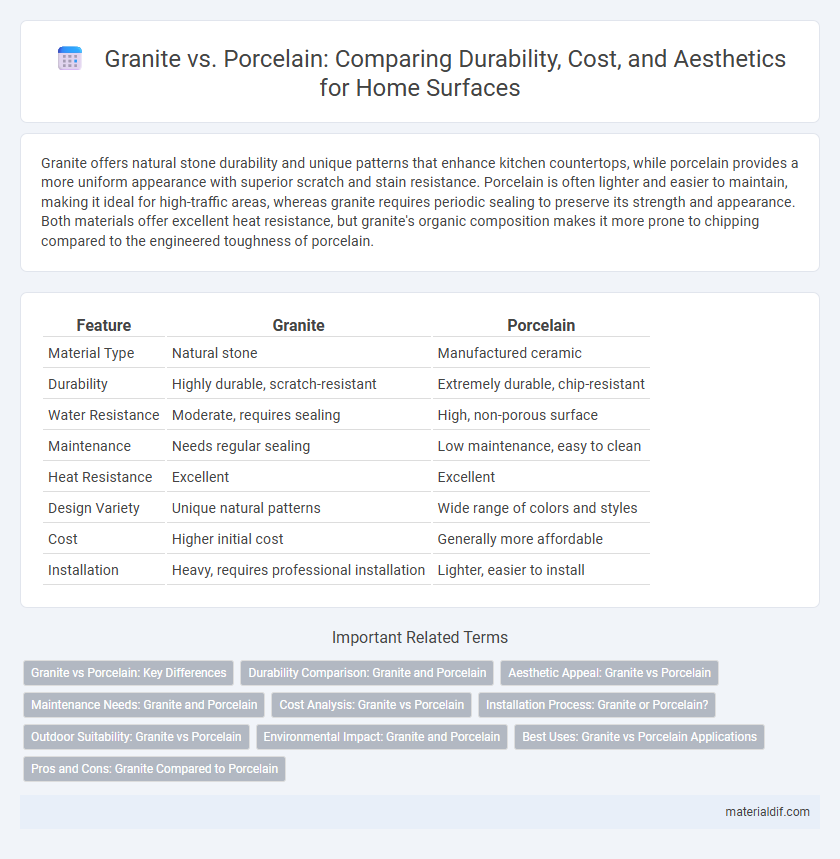Granite offers natural stone durability and unique patterns that enhance kitchen countertops, while porcelain provides a more uniform appearance with superior scratch and stain resistance. Porcelain is often lighter and easier to maintain, making it ideal for high-traffic areas, whereas granite requires periodic sealing to preserve its strength and appearance. Both materials offer excellent heat resistance, but granite's organic composition makes it more prone to chipping compared to the engineered toughness of porcelain.
Table of Comparison
| Feature | Granite | Porcelain |
|---|---|---|
| Material Type | Natural stone | Manufactured ceramic |
| Durability | Highly durable, scratch-resistant | Extremely durable, chip-resistant |
| Water Resistance | Moderate, requires sealing | High, non-porous surface |
| Maintenance | Needs regular sealing | Low maintenance, easy to clean |
| Heat Resistance | Excellent | Excellent |
| Design Variety | Unique natural patterns | Wide range of colors and styles |
| Cost | Higher initial cost | Generally more affordable |
| Installation | Heavy, requires professional installation | Lighter, easier to install |
Granite vs Porcelain: Key Differences
Granite is a natural stone characterized by its unique mineral composition and durability, making it highly resistant to heat and scratches, whereas porcelain is a manufactured ceramic material known for its uniform appearance and non-porous surface. Granite requires periodic sealing to prevent staining, while porcelain's dense, impervious surface offers superior stain resistance without maintenance. The choice between granite and porcelain depends on factors like aesthetic preference, maintenance requirements, and intended application in countertops or flooring.
Durability Comparison: Granite and Porcelain
Granite offers exceptional durability with high resistance to scratches, heat, and impact, making it ideal for heavy-use kitchen surfaces. Porcelain is also highly durable, featuring superior stain resistance and less porosity than granite, which reduces the risk of bacterial growth and water absorption. While both materials provide excellent longevity, granite is more prone to chipping under extreme force, whereas porcelain's hardness offers enhanced protection against abrasions.
Aesthetic Appeal: Granite vs Porcelain
Granite offers a unique, natural aesthetic with intricate patterns and rich color variations formed by mineral composition, making each slab one-of-a-kind. Porcelain provides a wider range of design options, including mimicking natural stone, wood, and concrete with consistent patterns and colors due to its engineered manufacturing process. The choice between granite and porcelain ultimately depends on whether a more authentic natural look or diverse stylistic versatility is prioritized.
Maintenance Needs: Granite and Porcelain
Granite requires regular sealing to prevent stains and maintain its durability, while porcelain is highly resistant to stains and typically does not need sealing. Both materials are easy to clean with mild detergents, but granite may show signs of wear without proper upkeep. Porcelain offers superior resistance to scratches and moisture, reducing long-term maintenance compared to granite surfaces.
Cost Analysis: Granite vs Porcelain
Granite countertops typically range from $40 to $100 per square foot, reflecting natural stone's premium durability and unique aesthetics. Porcelain slabs, priced between $50 and $120 per square foot, offer high resistance to scratches and heat but can be more costly due to advanced manufacturing processes. When factoring long-term maintenance and potential repairs, porcelain may present better value despite its higher upfront cost compared to granite.
Installation Process: Granite or Porcelain?
Granite installation requires professional expertise due to its heavy weight and the need for precise cutting and sealing, typically involving a longer timeline and higher labor costs. Porcelain tiles offer a more straightforward installation process, being lighter, easier to cut, and often available in tile format, which can reduce labor time and complexity. Choosing between granite and porcelain for installation depends on balancing durability needs with budget and project timelines.
Outdoor Suitability: Granite vs Porcelain
Granite exhibits exceptional durability and natural resistance to weather elements, making it an ideal choice for outdoor applications such as patios and walkways. Porcelain tiles, while also weather-resistant and less porous, offer greater color consistency and low maintenance but can be prone to cracking under extreme temperature fluctuations. Evaluating environmental conditions and usage intensity is crucial when selecting between granite and porcelain for outdoor suitability.
Environmental Impact: Granite and Porcelain
Granite extraction involves quarrying, which significantly disrupts ecosystems and consumes substantial energy, contributing to higher carbon emissions compared to porcelain. Porcelain production, primarily composed of refined clays and minerals, utilizes less energy-intensive processes and often incorporates recycled materials, resulting in a lower environmental footprint. Both materials are durable, but porcelain's manufacturing efficiency and reduced raw material depletion make it a more sustainable choice in terms of environmental impact.
Best Uses: Granite vs Porcelain Applications
Granite excels in high-traffic areas and kitchen countertops due to its superior durability, heat resistance, and natural aesthetic appeal, making it ideal for both indoor and outdoor applications. Porcelain offers greater versatility with its resistance to scratches, stains, and moisture, making it suitable for flooring, backsplashes, and wall cladding in wet environments like bathrooms and commercial spaces. Both materials provide excellent options depending on the specific requirements of durability, maintenance, and design preferences in residential or commercial projects.
Pros and Cons: Granite Compared to Porcelain
Granite offers exceptional durability, natural heat resistance, and unique, vibrant patterns that enhance kitchen aesthetics, whereas porcelain provides superior stain resistance and lower porosity, making it highly resistant to moisture and bacterial growth. Granite requires periodic sealing to maintain its appearance and prevent stains, while porcelain demands less maintenance and is less prone to chipping due to its dense composition. The cost of granite is generally higher and installation is more labor-intensive compared to the more affordable and lightweight porcelain options.
Granite vs Porcelain Infographic

 materialdif.com
materialdif.com